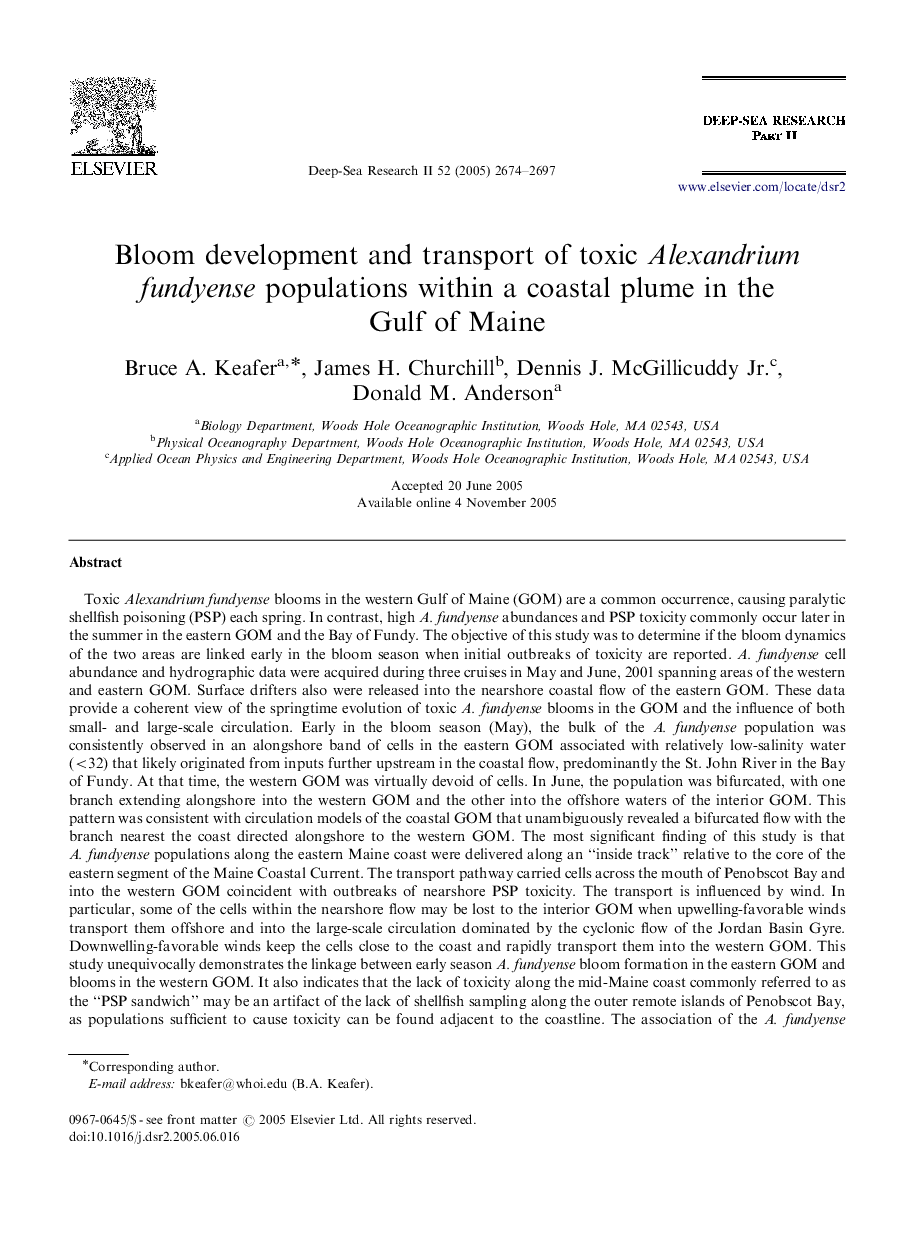| کد مقاله | کد نشریه | سال انتشار | مقاله انگلیسی | نسخه تمام متن |
|---|---|---|---|---|
| 4538589 | 1626522 | 2005 | 24 صفحه PDF | دانلود رایگان |
عنوان انگلیسی مقاله ISI
Bloom development and transport of toxic Alexandrium fundyense populations within a coastal plume in the Gulf of Maine
دانلود مقاله + سفارش ترجمه
دانلود مقاله ISI انگلیسی
رایگان برای ایرانیان
کلمات کلیدی
موضوعات مرتبط
مهندسی و علوم پایه
علوم زمین و سیارات
زمین شناسی
پیش نمایش صفحه اول مقاله

چکیده انگلیسی
Toxic Alexandrium fundyense blooms in the western Gulf of Maine (GOM) are a common occurrence, causing paralytic shellfish poisoning (PSP) each spring. In contrast, high A. fundyense abundances and PSP toxicity commonly occur later in the summer in the eastern GOM and the Bay of Fundy. The objective of this study was to determine if the bloom dynamics of the two areas are linked early in the bloom season when initial outbreaks of toxicity are reported. A. fundyense cell abundance and hydrographic data were acquired during three cruises in May and June, 2001 spanning areas of the western and eastern GOM. Surface drifters also were released into the nearshore coastal flow of the eastern GOM. These data provide a coherent view of the springtime evolution of toxic A. fundyense blooms in the GOM and the influence of both small- and large-scale circulation. Early in the bloom season (May), the bulk of the A. fundyense population was consistently observed in an alongshore band of cells in the eastern GOM associated with relatively low-salinity water (<32) that likely originated from inputs further upstream in the coastal flow, predominantly the St. John River in the Bay of Fundy. At that time, the western GOM was virtually devoid of cells. In June, the population was bifurcated, with one branch extending alongshore into the western GOM and the other into the offshore waters of the interior GOM. This pattern was consistent with circulation models of the coastal GOM that unambiguously revealed a bifurcated flow with the branch nearest the coast directed alongshore to the western GOM. The most significant finding of this study is that A. fundyense populations along the eastern Maine coast were delivered along an “inside track” relative to the core of the eastern segment of the Maine Coastal Current. The transport pathway carried cells across the mouth of Penobscot Bay and into the western GOM coincident with outbreaks of nearshore PSP toxicity. The transport is influenced by wind. In particular, some of the cells within the nearshore flow may be lost to the interior GOM when upwelling-favorable winds transport them offshore and into the large-scale circulation dominated by the cyclonic flow of the Jordan Basin Gyre. Downwelling-favorable winds keep the cells close to the coast and rapidly transport them into the western GOM. This study unequivocally demonstrates the linkage between early season A. fundyense bloom formation in the eastern GOM and blooms in the western GOM. It also indicates that the lack of toxicity along the mid-Maine coast commonly referred to as the “PSP sandwich” may be an artifact of the lack of shellfish sampling along the outer remote islands of Penobscot Bay, as populations sufficient to cause toxicity can be found adjacent to the coastline. The association of the A. fundyense populations with low-salinity water near the coast requires a refinement of the terminology for the eastern Maine Coastal Current to distinguish this nearshore water mass from the adjacent, more saline offshore waters. We name this feature the Gulf of Maine Coastal Plume (GOMCP) to reflect the freshwater inputs into the GOM that are critically important in the long-distance transport and growth of A. fundyense populations along the New England coast. The GOMCP is likely to be important for other organisms as well.
ناشر
Database: Elsevier - ScienceDirect (ساینس دایرکت)
Journal: Deep Sea Research Part II: Topical Studies in Oceanography - Volume 52, Issues 19â21, SeptemberâOctober 2005, Pages 2674-2697
Journal: Deep Sea Research Part II: Topical Studies in Oceanography - Volume 52, Issues 19â21, SeptemberâOctober 2005, Pages 2674-2697
نویسندگان
Bruce A. Keafer, James H. Churchill, Dennis J. Jr., Donald M. Anderson,